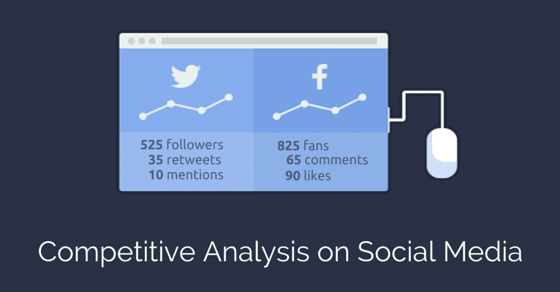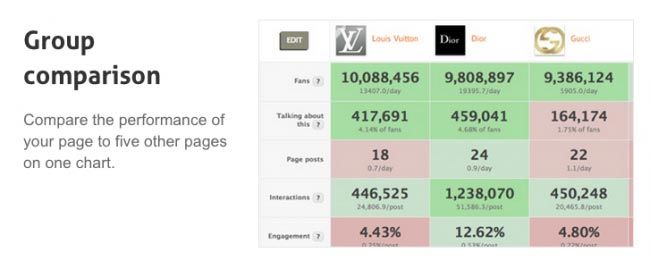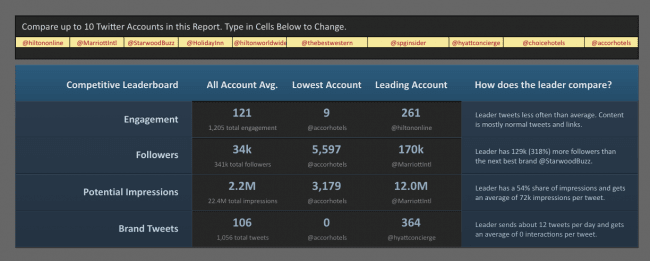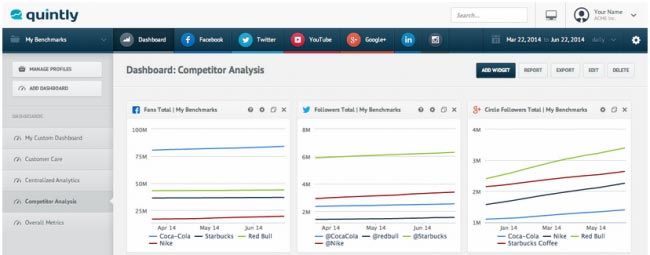Most wars have more than one front, and business is no different. One of the newest fronts – an important one, the one we’ll talk about today – is social media. Social networks like Facebook, Twitter, and Instagram are more popular than ever. A full 70% of marketers are expected to spend more on social media ads this year.
To make the most of your social media investment – and outclass your rivals there – you have to look outside yourself and analyze what the competition is doing. Basically, you have to spy on them.
Thankfully, you don’t need to break any laws – or windows! – to get your hands on their secrets. Just follow our advice here for the right tools and strategies to make your social espionage campaign successful.
1. Tools
Before you can spy on anybody, you need the right tools to do it. Thankfully, there are more than a few exceptional choices in the social competitive analysis market today:
I. Agorapulse
Yours truly, Agorapulse, is our first recommendation, providing a strong competitor benchmark for Facebook pages, targeting fan counts, page posts, engagement, and more.
You can move pages in and out of your charts as you like, depending on which rivals you’re concentrating on at the moment. It’s particularly easy to customize and data changes are color-coded to make reading them easy at a glance.
It’s a good all-around choice, but its pricing structure and user-friendly format make it especially ideal for small businesses.
II. Simply Measured
Simply Measured is a more robust platform, but it’s also more expensive.
Intended more for larger – even enterprise – companies, it offers more exhaustive data in an easily accessible way, and it supports multiple social networks. You can benchmark your performance against your competitors on Twitter, Instagram, and more.
If you have a larger organization, budget, and range of social networks, Simply Measured is a fine choice.
III. Quintly
Quintly represents a good middle ground between the small to medium size business focus of AgoraPulse and the enterprise-oriented SimplyMeasured.
You’ll find similar functionalities here, just at a lower price point than Simply Measured. You can also track results across multiple social networks, from Twitter to Facebook, and put several competitors in a single graph.
2. Strategies
Now that you have a social CRM with competitive benchmarking, you can start digging into the data. Specifically, you can start comparing your actions against your rivals.
There are many ways to take advantage of this information and every business is different. That said, there are quite a few that simply work for most organizations. B2B, B2C, start-up and enterprise organizations alike.
We’re going to go over a few of them here.
I. Content Strategy Ideas
When you’re just starting out, posting on your Facebook page for the first time, you might not be sure exactly what to do. You could be new to social media marketing in general, or you may just not know how to properly express your company and what it’s selling there. Like so many of us, you might just sit and think and worry about that first move.
Thankfully, there’s a relatively safe move to start with. You’re not inventing an industry, presumably. You’re selling in an existing one. So, take a look at what your competitors are doing. Look at their posts on Facebook, Twitter, Facebook, Instagram, and elsewhere.
Think about:
- How often they post
- The kind of content they post (text, pictures, videos, etc.)
- What days and times they post on
- The tone and voice of their posts
- The way they engage with their fans in the comments
From here, you can alter the details to fit your unique value proposition. It’ll probably be similar, of course, so you shouldn’t have to do too much work here. But at the very least, you have an idea of where to start, and you can see if those ideas work for companies like yours by reviewing your competitors’ performance data.
[Tweet “Competitive analysis on Social Media can help you improve your content strategy”]
II. Setting Benchmarks for Your Goals
Like many things, social media success is defined in relative terms. If you don’t know what “good” numbers are, you don’t know what to strive for. You could be doing well or you could be doing poorly, but you won’t be able to tell – and then do more of the same or adjust your strategy – until you know the industry averages.
And that’s where spying on your competitors comes in. Take your biggest rivals. The ones that compete directly in your space for the same prospects you’re marketing to. Then, open your social CRM and figure out how many fans they generally acquire each month and what their usual engagement rates are. Look at all the data that’s important to you.
Those numbers – what your competitors are making – are your benchmarks. You’re successful when you do better.
[Tweet “Beating your competitors on Social Media will make you feel good. That’s a good start :-)”]
III. Monitoring Changes in Competitor Behavior
Sudden changes in the marketplace – like the introduction of a new product category – can change everything.
You want to know about these introductions – or significant changes of any kind – as early as you can when you’re not the one making them. The more time you have to react, the better you’ll fare.
So, keep an eye on the Facebook pages and Twitter profiles of your competitors. Don’t just watch for changes in the kinds of content they’re posting – those are important too, though – but also look for massive surges in fan acquisition, engagement, and so on. They probably have a consistent rate, so something truly out of the ordinary probably means something. Follow up on that.
If it’s a bad change, if they’re losing fans or getting fewer of them to interact, that’s an opportunity too. Use a social CRM to notify you whenever something like that happens, so you don’t miss out.
IV. Making Your Progress Reports Better
If you’re a social media manager and you have to report to somebody not fluent in what you do, as you probably have to, you know it can be difficult to convince them of the value your work has, let alone get them to understand what your results mean. Senior management certainly doesn’t know if getting 100 new fans a month is good or bad. You have to translate your results into a language they understand.
So, don’t say your engagement rate doubled last month. Say you’re getting twice as much engagement as your competitors. Similarly, don’t say you have a 200 social shares a month on Facebook. Say that your fans – your customers – are doing product evangelism work for you, and you’re getting more of it per-fan than your rivals are.
When you’re doing better than the competition in any way, your higher-ups generally understand. And they’re generally very happy with it too.
[Tweet “When benchmarking competitors’ engagement on social media, look at % of engaged users, not total number”]
Social espionage is a good place to start, and a good regular strategy to employ. But, all those insights have to be interpreted and acted on or they’re meaningless.
That means having a process in place for that is critical. You don’t want that valuable data going to waste.
If you do a little spying here and there, let us know what generally works for you. What numbers do you consider the most important and where do you find them?
Tell us in a comment below.
Related Post: Social Media Marketing 101








